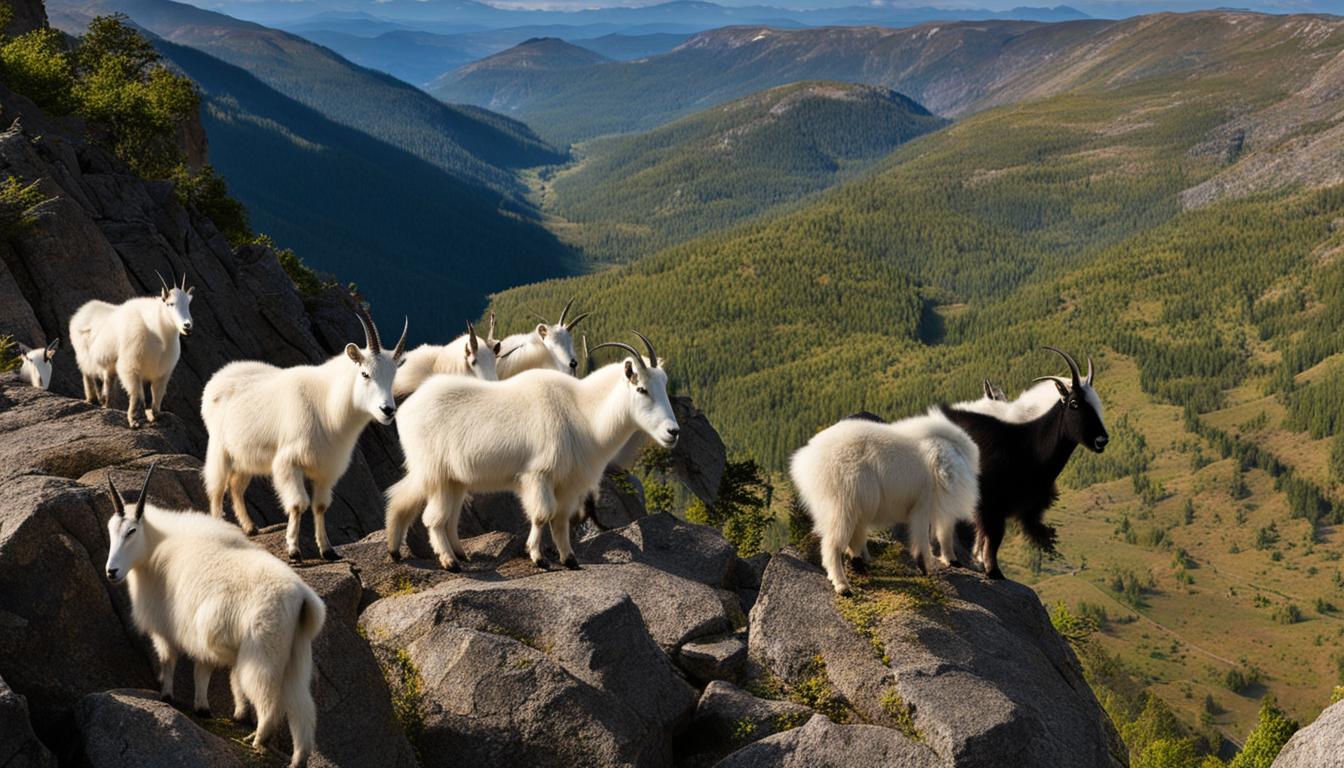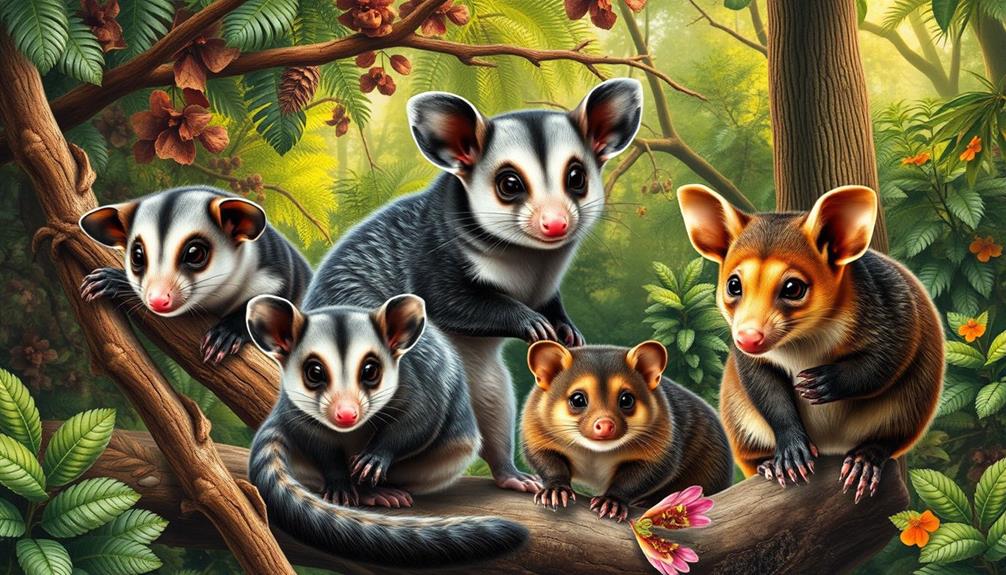Did you know that the Swiss Alps are home to a diverse range of mountain animals? These high-altitude wonders have not only survived but thrived, thanks to dedicated conservation efforts and protective measures. From agile climbers to majestic creatures, the alpine wildlife in the Swiss Alps is truly impressive.
Explore the diverse species that call this breathtaking mountain range their home. From chamois leaping across rocky terrains to ibex with their magnificent scimitar-shaped horns, each animal has its own unique characteristics and adaptations to the demanding alpine habitat.
In this comprehensive guide, we’ll take you on a journey through the extraordinary world of mountain animals in the Swiss Alps. Get ready to be amazed by the resilience and beauty of these remarkable creatures.
Key Takeaways:
- Conservation efforts have allowed alpine wildlife in the Swiss Alps to make a comeback.
- Chamois are agile climbers, capable of ascending 1000 meters in just 15 minutes.
- Ibex, with their distinctive scimitar-shaped horns, were successfully reintroduced after near extinction.
- The red deer, the largest deer species in Europe, has made a population recovery.
- Marmots are sociable ground squirrels that prepare for hibernation by increasing their body weight.
Chamois: Agile Climbers of the Alps.
Chamois, the agile mountaineers of the Swiss Alps, are goat-like animals that thrive in the alpine habitat. With their remarkable climbing skills, they can ascend rocky terrain and steep slopes with ease. In fact, when threatened, chamois can scale an impressive 1000 meters in just 15 minutes, seeking safety in high-altitude cliffs and crags.
One distinguishing feature of chamois is their distinctive white facial markings, which contrast against their brown bodies. They also have a brown stripe along their backbone. These unique markings make them easily identifiable amidst the rugged landscapes of the Alps.
Chamois are well-adapted to their challenging environment. Their nimble hooves provide them with exceptional grip and balance on the rocky surfaces they traverse. They can be spotted gracefully maneuvering through rocky terrain and scaling steep cliffs. Occasionally, they venture into forests in search of food or for shelter when necessary.
| Chamois Characteristics | Details |
|---|---|
| Appearance | White facial markings and brown stripe along the backbone |
| Adaptations | Nimble hooves for climbing rocky terrain |
| Habitat | Steep, rocky terrain with occasional forays into forests |
| Protective Measures | Laws and conservation efforts |
Thriving in a Challenging Habitat
Chamois are renowned for their agility and remarkable ability to navigate the rocky terrain of the Swiss Alps. Their specialized adaptations, such as their nimble hooves, allow them to traverse the steep slopes and precipitous cliffs with ease.
To ensure the preservation of chamois and their alpine habitat, protective measures have been put in place. Conservation organizations, national parks, and hunting regulations work together to safeguard these remarkable creatures and ensure their population remains stable.
By understanding the unique characteristics of chamois and implementing protective measures, we can ensure the continued existence of these agile climbers in the magnificent landscapes of the Swiss Alps.
Ibex: Majestic Mountain Goats.
The Alpine ibex is a mountain goat species known for its majestic presence in the Swiss Alps. These remarkable creatures were once on the brink of extinction due to extensive hunting in the early 19th century. However, thanks to successful reintroduction efforts, the ibex population has made a remarkable recovery in recent years.
Ibex are characterized by their impressive scimitar-shaped horns, which curve backward and can reach lengths of up to 1 meter (3.3 feet). These striking horns are more prominent in males, displaying ridges and spirals that add to their overall magnificence. Female ibex also possess horns, albeit shorter and more slender compared to their male counterparts.
In their natural habitat, ibex roam the rocky regions above alpine forests, thriving in the challenging terrain. Their powerful hooves provide excellent grip, allowing them to navigate steep cliffs and find sustenance in otherwise inaccessible areas. With a height range of 27 to 43 inches at the shoulder, these agile climbers can effortlessly traverse the precipitous slopes of the Swiss Alps.
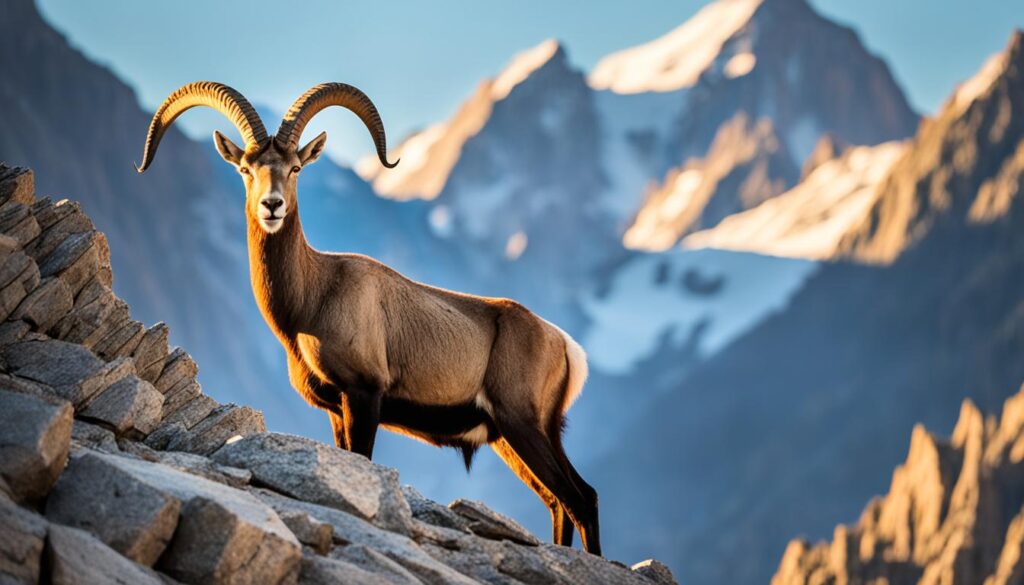
“The reintroduction efforts have been vital in bringing the ibex back from the brink of extinction,” says Dr. Sarah Thompson, a wildlife conservation specialist. “These iconic mountain goats play a crucial role in maintaining ecosystem balance, and their successful recovery is a testament to the efficacy of conservation measures.”
Reintroducing the ibex to its natural habitat has not only rejuvenated the species but also contributed to the overall biodiversity and ecological health of the Swiss Alps. By sustaining a diverse range of alpine wildlife, these magnificent creatures ensure the delicate balance of nature is preserved for future generations.
| Ibex Facts | |
|---|---|
| Habitat | Rocky regions above alpine forests |
| Horns | Large, scimitar-shaped, curved backward |
| Horn Length | Up to 1 meter (3.3 feet) |
| Population Range | 27 to 43 inches at the shoulder |
| Status | Reintroduced successfully after near extinction |
With their undeniable grandeur and crucial role in the alpine ecosystem, the ibex stands as a testament to the triumphs of conservation. By protecting these magnificent creatures, we safeguard the future of the Swiss Alps and support the delicate balance of nature in this breathtaking mountain range.
Red Deer: Majestic Creatures of the Alps.
The red deer, also known as Cervus elaphus, is the largest deer species in Europe and an iconic symbol of the Alps. With their majestic stature and impressive antlers, red deer are a magnificent sight to behold. Unlike their North American counterparts, such as mule deer or whitetail deer, red deer are renowned for their larger size and regal presence.
Once near extinction in Switzerland, red deer have made a remarkable population recovery thanks to dedicated conservation efforts. Protected spaces and controlled hunting have played a vital role in their resurgence. Additionally, the red deer’s ability to migrate across vast distances has facilitated the expansion of their population throughout the Alpine region.
Forest Habitat and Behavior
Red deer are well-adapted to their forest habitat, making their homes in deep woodland settings below the treeline. They thrive in diverse ecosystems rich with vegetation, including deciduous and coniferous forests. These forested areas provide ample coverage and an abundant food supply, including grass, leaves, and bark.
During mating season, or “rut,” male red deer engage in fierce battles, competing for the attention of females. The clash of antlers echoes through the forest, a display of dominance and strength. The victorious males earn the right to mate and pass on their genes, ensuring the survival of their lineage.
“The red deer, with its imposing size and resplendent antlers, commands the attention of all who encounter it in the Alpine forests.” – Wildlife enthusiast
Population Distribution
Red deer populations are not restricted to any specific region within the Alps, but rather can be found across the entire mountain range. However, their distribution is influenced by factors such as food availability, shelter, and human activities.
While red deer are known to roam freely through the rugged Alpine landscapes, certain areas have become more synonymous with their presence. For example, the Bernese Alps and Graubünden are renowned for their substantial red deer populations.
The fluctuating nature of red deer populations, as they move in response to changing environmental and habitat conditions, ensures their resilience and adaptability. It also contributes to the overall biodiversity and ecological balance of the Alpine ecosystem.
Inhabitants of the Forest Kingdom
Red deer share their forest habitat with a diverse array of wildlife. From nimble chamois to elusive lynx, these animals navigate the dense woodlands, forming an intricate web of ecological interactions. The presence of red deer provides a critical food source for carnivores, such as lynx and wolves, which rely on the deer as a primary prey species.
This delicate balance illustrates the interconnectedness of Alpine wildlife and underscores the importance of protecting the forest habitat that sustains them. Through continued conservation efforts, we can ensure the long-term survival of not only red deer but all the majestic creatures that call the Alps home.
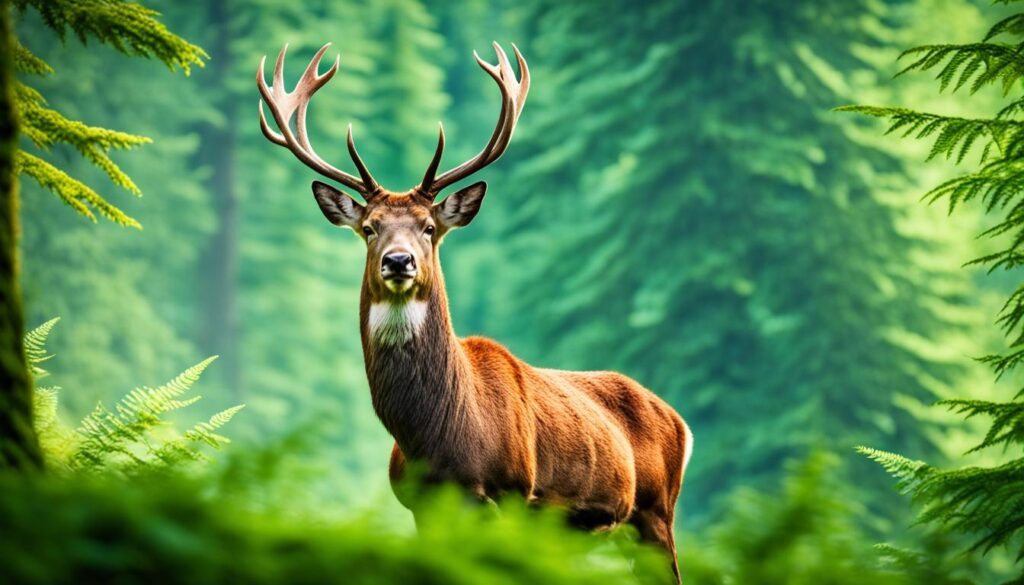
| Red Deer Facts | |
|---|---|
| Scientific Name: | Cervus elaphus |
| Family: | Cervidae |
| Height: | 4.2–4.8 ft at the shoulder |
| Weight: | 300–500 lbs (males), 200–300 lbs (females) |
| Antler Size: | Up to 3.9 ft wide and 4.3 ft tall |
| Preferred Habitat: | Forest and woodland habitats |
| Life Expectancy: | Approximately 15 years in the wild |
Marmots: Sociable Ground Squirrels.
Alpine marmots, the largest members of the squirrel family, are a common sight in the Swiss Alps. These sociable creatures make their homes in underground burrows, specially designed to provide protection and shelter.
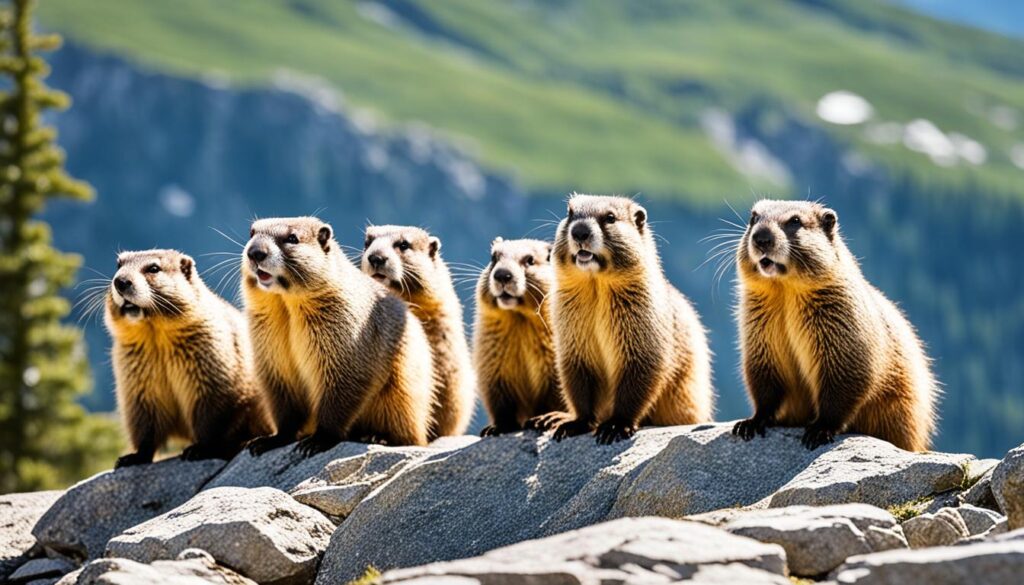
Living in high-altitude habitats, marmots have adapted to the challenging alpine conditions. They are excellent diggers, creating intricate burrow systems that consist of multiple chambers for different purposes. These burrows serve as safe spaces for hibernation during the harsh winter months and protection from predators.
Marmots go through a fascinating hibernation process to survive the winter. In preparation, they increase their body weight by feeding on plants to store enough fat reserves. This enables them to endure the long periods of hibernation without eating. As the spring arrives, marmots awaken from their slumber and emerge from their burrows to enjoy the warmer weather and the abundance of food.
These charming rodents are known for their sociable nature. They live in large groups called colonies, often consisting of closely related individuals. Within these colonies, marmots communicate with each other through a variety of vocalizations, including whistles. These whistles serve as alarms to alert the colony of potential threats.
Marmots have a diverse diet, primarily consisting of plants, including grasses, leaves, and flowers. However, they are opportunistic eaters and also consume insects when the opportunity arises. This varied diet ensures their survival in the alpine environment, where food sources can be limited.
During the spring mating season, female marmots give birth to litters of typically three babies, called pups. These adorable youngsters stay within the safety of the burrow until they are old enough to join the rest of the colony.
Fun Fact:
Marmots are excellent swimmers, and they are known to dive into lakes and rivers to escape predators or simply cool off during hot summer days.
| Characteristics | Details |
|---|---|
| Family | Squirrel family (Sciuridae) |
| Size | Approximately 20-27 inches long and 7-13 pounds in weight |
| Habitat | Alpine meadows and rocky slopes at high elevations |
| Lifespan | Average of 12-15 years in the wild |
| Behavior | Social, living in colonies |
| Conservation Status | Least Concern |
With their endearing presence and fascinating behaviors, marmots bring life and charm to the alpine habitat. These resilient creatures are a testament to the adaptability and biodiversity found in the Swiss Alps.
Nuthatch: Small Forest Bird.
The nuthatch is a small bird commonly found in the forested regions of the Swiss Alps, where it thrives in its natural habitat. With its unique characteristics and behaviors, the nuthatch plays an important role in the ecosystem of these mountainous areas.
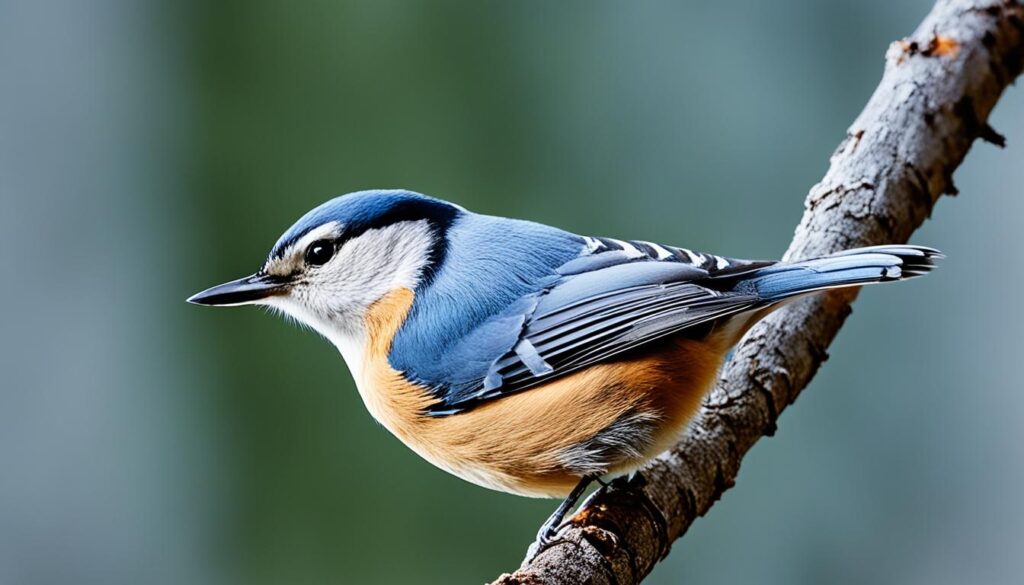
The nuthatch is easily recognizable by its large head, short tail, and powerful beak and feet. These features allow it to maneuver adeptly among the trees and extract food from various sources.
One fascinating aspect of the nuthatch is its omnivorous diet. It feeds on a diverse range of food, including insects, nuts, and seeds. This adaptability enables the nuthatch to sustain itself in the ever-changing environment of the forested regions.
Another intriguing behavior of the nuthatch is its food caching ability. It stores food in different locations, creating hidden reserves to rely on during harsher times. This resourceful behavior helps ensure its survival when food sources become scarce.
During benign conditions, the nuthatch avoids using its stored food caches, saving them for when they are truly needed. This prudent strategy demonstrates the nuthatch’s ability to plan for the future and adapt to the demands of its environment.
The presence of the nuthatch in the forested regions of the Swiss Alps contributes to the overall biodiversity of the area. Its feeding habits and food caching behavior play a vital role in the dispersal of seeds, contributing to the regeneration and growth of the forest ecosystem.
The Role of the Nuthatch in Maintaining Forest Health
“The nuthatch’s omnivorous diet and food caching behavior make it a key player in sustaining the balance of the forested regions. By dispersing seeds and consuming various food sources, it contributes to the overall health and resilience of the ecosystem.”
| Nuthatch Characteristics | Behaviors |
|---|---|
| Large head | Omnivorous diet |
| Short tail | Food caching behavior |
| Powerful beak and feet | Seed dispersal |
The table above summarizes the key characteristics and behaviors of the nuthatch. These attributes enable it to survive and thrive in the forested regions of the Swiss Alps, making it an integral part of the alpine ecosystem.
Fox: Agile Omnivorous Mammal.
Foxes are fascinating creatures that can be found in the forests throughout the Swiss Alps. They are agile and adaptable, making them well-suited to various environments. The fox species commonly found in this region is the European red fox (Vulpes vulpes).
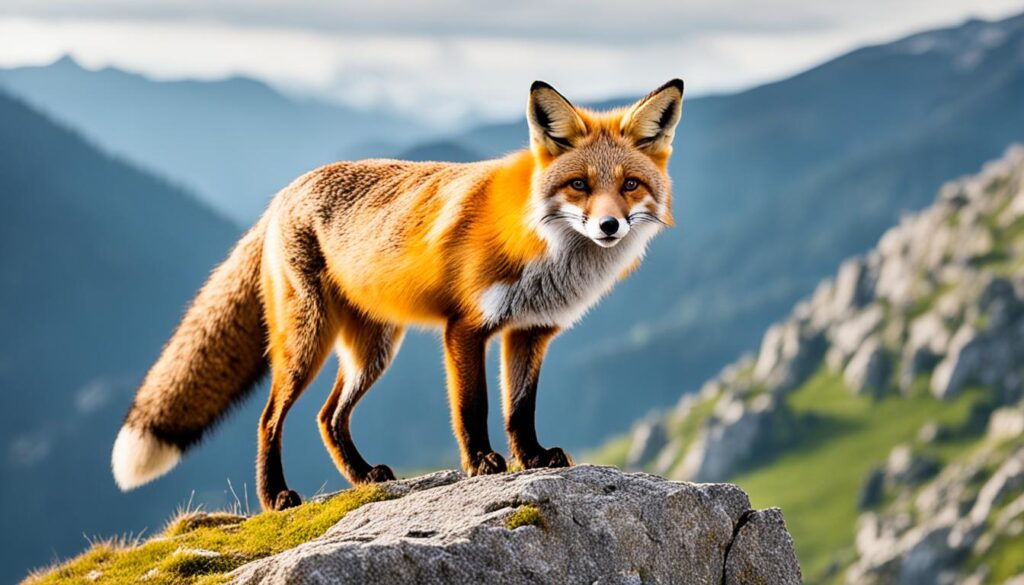
European red foxes are omnivorous, meaning they have a diverse diet that includes both plant matter and animal prey. They are opportunistic feeders, which enables them to survive in different habitats. One of their primary hunting targets in the Swiss Alps is rodents, such as mice and voles, which are abundant in the forest undergrowth.
The forest habitat provides ample cover and food sources for foxes. The dense vegetation allows them to move stealthily and hunt their prey effectively. They use their keen senses, including sharp hearing and a keen sense of smell, to locate food and navigate through the forest.
“Foxes are incredibly resourceful and have adapted well to the changing landscapes in the Swiss Alps. Their ability to thrive in both natural forest habitats and urban areas is a testament to their versatility.”
In recent years, there has been a noticeable increase in fox populations in urban areas, including cities like Zurich. This can be attributed to reduced hunting activity and the availability of food sources, such as garbage bins and small pets. In fact, it is estimated that there are currently about 1,200 foxes residing in Zurich alone.
Despite their presence in urban environments, foxes still prefer forest habitats and tend to form small family groups consisting of an adult pair and their offspring. They are primarily nocturnal animals, becoming more active during the twilight hours and throughout the night.
Did You Know? The European red fox is the largest fox species and has a reddish-brown coat with a white underbelly and a bushy tail.
In conclusion, foxes play an integral role in the ecosystem of the Swiss Alps. Their adaptability and hunting skills make them well-suited to both forested landscapes and urban environments. By understanding and appreciating these agile omnivores, we can ensure their continued coexistence with humans and other wildlife in this remarkable region.
Lynx: Silent Solitary Predators.
The Eurasian lynx, known as the largest of the lynx species, faced extinction in Switzerland but was successfully reintroduced in the 1970s. These majestic felines have a solitary and territorial nature, preferring the solitude of high-altitude forests in the Swiss Alps.
The lynx, scientifically referred to as Lynx lynx, primarily preys on roe deer and chamois, showcasing its powerful and stealthy hunting abilities. With their keen senses and muscular bodies, lynx can silently stalk and pounce on their unsuspecting prey.
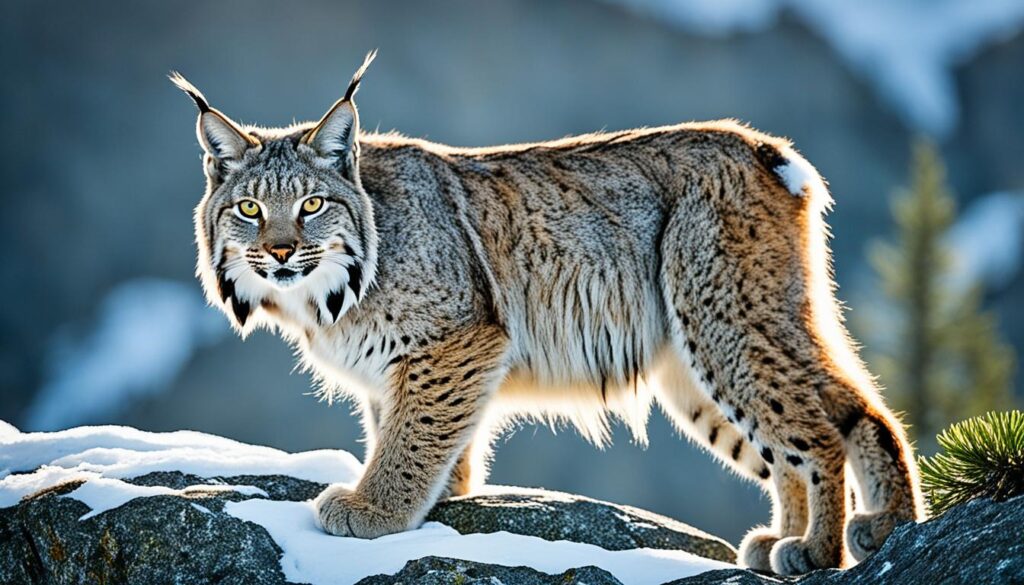
Currently, there are approximately 170 lynx living in Switzerland, with a steady population increase due to the successful reintroduction efforts. However, their presence also brings about conflicts with farmers, particularly when lynx target sheep as a food source. Balancing the conservation of these magnificent creatures and the needs of local communities remains a challenge.
“The reintroduction of lynx in Switzerland is a testament to the importance of preserving biodiversity and the delicate balance between human activity and wildlife conservation.” – Dr. Maria Schneider, Wildlife Conservation Expert
Lynx Characteristics:
- Silent and solitary predators
- Largest of the lynx species
- High-altitude forest dwellers
- Prey primarily on roe deer and chamois
- Reintroduced to Switzerland in the 1970s
Lynx Population in Switzerland:
| Year | Number of Lynx |
|---|---|
| 2000 | 50 |
| 2010 | 100 |
| 2020 | 170 |
Conclusion.
The Swiss and French Alps are teeming with a diverse range of mountain animals, making it a paradise for nature enthusiasts. Thanks to protective measures and dedicated conservation efforts, various alpine wildlife populations have experienced a remarkable resurgence.
However, it is crucial to acknowledge that conflicts between wildlife and human activities, particularly in farming areas, can still occur. Balancing the coexistence of these magnificent creatures and human needs is a pressing matter that requires ongoing conservation initiatives and community involvement.
Preserving the biodiversity of alpine wildlife is of utmost importance. By implementing sustainable practices and promoting coexistence programs, we can ensure the continued harmony of these high-altitude wonders. These conservation efforts play a vital role in maintaining the delicate ecosystem of the Alps, safeguarding the rich biodiversity that exists within its breathtaking landscapes.
